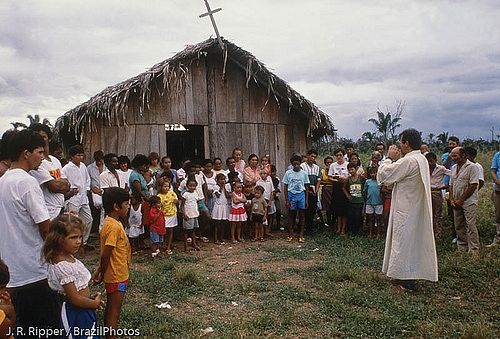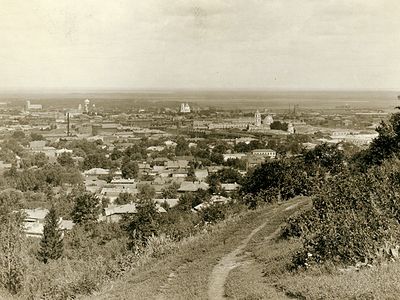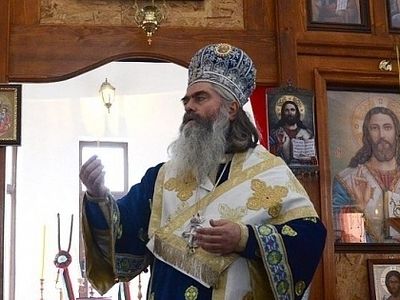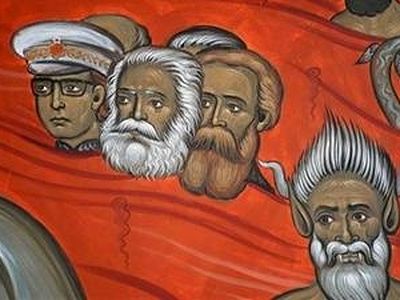Source: Catholic Moral Theology

Was Latin American liberation theology an invention of the Soviet KGB? So argues Ion Mihai Pacepa, a former intelligence official under Romania’s communist regime, first in an essay published on National Review Online, and later in an interview at Catholic News Agency. Pacepa’s account is almost certainly false, but it feeds into many Catholics’ knee-jerk hostility to liberation theology, as a result of its troubles with the Vatican, ignoring the two’s quite complicated relationship. At dotCommonweal, David Gibson rightly takes the CNA interviewer to task for letting Pacepa make his claims evidence-free, but it is also necessary to set the historical record straight. Pacepa weaves together indisputable facts about Soviet efforts to manipulate religion with a profound ignorance of liberation theology to create a wildly implausible account of the movement’s origins, and in the process ironically demonstrates an understanding of the human person and history similar to that of the most extreme forms of liberation theology, rightly condemned by the Vatican.
According to Pacepa, liberation theology had its beginnings in 1959-60, with Soviet premier Nikita Khrushchev’s plans to export Soviet communism to Latin America, and to infiltrate and co-opt worldwide Christianity. For this latter purpose, in 1968 the KGB created the Christian Peace Conference, based in Prague, Czechoslovakia, and later that same year, he claims, “the KGB-created Christian Peace Conference, supported by the world-wide World Peace Council, was able to maneuver a group of leftist South American bishops into holding a Conference of Latin American Bishops at Medellin, Colombia.” In Pacepa’s telling, the Medellin conference launched liberation theology.
There are so many factual errors in this narrative it is hard to keep count. For one, the Latin American Bishops’ Conference, CELAM, was established in cooperation with the Vatican in 1955 and held its first meeting in that year in Rio de Janeiro, Brazil. The conference had always intended to meet once a decade, so there was no need for any bishops to be “maneuvered” into meeting at Medellin in 1968. Also devastating for Pacepa’s account, the planning for the meeting began almost immediately after the Second Vatican Council ended in 1965, three years before the Christian Peace Conference came into existence. Indeed, the meeting was planned to implement the council’s teaching in the Latin American context. Also, the final documents of the Medellin conference met with the approval of the vast majority of bishops present, which would be hard to explain in Pacepa’s telling.
Pacepa’s story also really has no explanation of how the actual theology came to be. For starters, although Gustavo Gutiérrez’s seminal work A Theology of Liberation was published in 1971, he presented the key ideas that later became that work at a conference in Peru in July, 1968, as “Hacia una teología de liberacion.” And of course this was a good two months before the bishops met in Medellín. Pacepa has the order of causation backwards; it was not a cabal of leftist bishops who sent out the theologians with marching orders, but rather the theologians who advised the bishops. But even aside from the dates, the most implausible thing about Pacepa’s theory is this: regardless of what one thinks about its conclusions, Gutiérrez’s work and that of the other most prominent liberation theologians are works of great intellectual sophistication. Likewise, Gutiérrez’s We Drink From Our Own Wells is a spiritual masterpiece, drawing on the Ignatian and Carmelite traditions, as well as the spirituality of the poor Gutiérrez lived among. It is just silly to think this work could be produced at the instigation of KGB goons, and Pacepa doesn’t even try to explain how this happened. He doesn’t really seem interested in the theology at all, having only “glanced” at A Theology of Liberation.
Works of sophistication depend on intellectual tradition, and understanding the background for Gutiérrez’s work puts one more nail in the coffin of Pacepa’s fantasy. Gutiérrez did his studies in France under the likes of Henri de Lubac, Yves Congar, and Marie-Dominiqiue Chenu, all of whom went on to shape the work of the Second Vatican Council. Gutiérrez’s theology is to a significant degree shaped by theirs, as well as by others such as the German Karl Rahner. Gutiérrez was also profoundly impacted by the Catholic social movements emerging in Western Europe in the 1940s and 1950s, such as the Mouvement Populaire des Familles and above all the worker priests, some of whom were engaged with Marxism. As a number of works (here, here, and here) have shown, these movements developed key ideas later taken up by the Latin American liberation theologians. Obviously there is no need for a secretive KGB intervention to account for the origins of liberation theology, as the plain facts provide a more plausible explanation.
An underlying weakness of Pacepa’s theory is his vague understanding of what liberation theology even is: “Liberation theology has been generally understood to be a marriage of Marxism and Christianity.” With such a simplistic definition, it is easy to see how he could conflate the crude Marxist Christianity of the Christian Peace Committee with liberation theology. But even the Marxist influence on liberation theology does not require mysterious KGB agents for an explanation. Western European Catholic intellectuals had been engaging with Marxist thought for several decades prior to the emergence of liberation theology, most notably Chenu and the French social movements mentioned earlier. Likewise, in Italy a group of “cattolici communisti” was established in 1937 that continued to have a small influence into the 1940s. And what is significant about these movements, for reasons that will become clear, is that for the most part they were influenced by allegedly more humanist, anti-Soviet forms of Marxism. For example, many of the French movements eventually became affiliated with the Parti Socialiste Unifié, an anti-Soviet, New Left socialist movement. This was one stream of Christian engagement with Marxism that directly poured into liberation theology.
Pacepa also seems unaware that there were currents of Marxism indigenous to Latin America that also shaped liberation theology. For example, Gutiérrez openly expresses his debt to José Carlos Mariátegui, his fellow Peruvian who in the 1920s developed a distinctively Latin American Marxism. Perhaps even more significantly, liberation theology drew significantly from dependency theory, a variation of Marxism that departed from the orthodox theory by giving much greater significance to the position of a nation within the global economy, rather than just analyzing the class relations within a single nation. Dependency theory divided the world into the “core” industrialized nations, and the “periphery” of nations focused on producing raw materials, the latter of which included Latin America. And, in most versions of the theory, the core included the Soviet Union, as well as the United States and Western Europe. Indeed, here we see the idea of the Third World, the Global South, oppressed by both the First and Second Worlds, the Global North.
I am giving so much emphasis to these Marxist influences on liberation theology to bring home the point that the predominant influences were clearly anti-Soviet. So on top of everything that makes Pacepa’s account so implausible, it simply doesn’t make any sense that, after the Soviet crackdowns on the Prague Spring and Polish uprising in 1968, both attempts to put a more “human face” on communism, and in the midst of the ongoing rifts with Yugoslavia and China, that the KGB would sink significant resources into a movement with such pronounced anti-Soviet influences.
Now, the tragic irony of Pacepa’s faulty account is that, in his telling of it, he demonstrates the very crude Marxist views of the human person and history that allegedly marred liberation theology, the very things that would lead Catholics with a pre-existing negative attitude toward liberation theology to accept Pacepa’s account at face value. Long after defecting from the Eastern Bloc, Pacepa still seems to think like a communist apparatchik.
For Pacepa, apparently, the vast majority of humankind are pawns or dupes, tossed about by forces beyond their control, but a small, elite vanguard are able to master these forces to their own ends, behind the scenes. Communist bigwigs plot the course of history over vacation; the KGB creates international social movements out of thin air; the Latin American bishops are “maneuvered” into doing the Soviets’ bidding. No one, in his telling, but this vanguard exercises any agency. The truth is, however, that liberation theology would not have had any influence whatsoever without the base ecclesial communities, gatherings of the poor themselves who, through reflecting on the gospel, began to exercise agency of their own.
Similarly, what counts for Pacepa is power, not ideas. He shows no interest whatsoever in the intellectual origins of liberation theology, and its seminal work worthy of no more than a “glance.” In classic Marxist fashion, ideas are a mere “superstructure” reflecting the more fundamental, materialist “base.” He shows no interest in where ideas come from or how they motivate people to act. But, surely, one of the failures of communism was its inability to see how culture and ideas have the power to change the world.
Finally, the curious thing about Pacepa’s argument is that he never explicitly answers the crucial question, “So what?” What difference would it make if the KGB had supported liberation theology? The implied answer, however, is that this would be proof that liberation theology is bad. But it is important to remember that, in the Congregation for the Doctrine of the Faith’s 1984 Instruction on Certain Aspects of Theology of Liberation, perhaps the central error of “certain forms of liberation theology” is this:
The only true consciousness, then, is the partisan consciousness. It is clear that the concept of truth itself is in question here, and it is totally subverted: there is no truth, they pretend, except in and through the partisan praxis (VIII.4).
What matters is what team you play on, and if you play for the other team, then I know you are wrong. Of course, now the teams are defined not in terms of class struggle, but of a Manichaean Cold War struggle between good and evil, but either way, as this passage points out, such a view subverts the truth. For example, the Soviet Union provided support to the African National Congress in its struggle against Apartheid in South Africa (while to its shame, the U.S. government supported the South African regime); does that invalidate the anti-Apartheid struggle? Such a perspective also masks the horrible things my team, the good team, with a veneer of “truth”—support for murderous regimes in Argentina, Chile, and El Salvador; support for the apartheid state in South Africa.
It is certainly right to question liberation theology’s use of Marxism, both as an analysis of society and as a philosophy, but this does not mean accepting without question a fable about the movement’s origins. As the Vatican’s Instruction makes clear, we should never compromise our commitment to truth, either in theological reflection or in historical memory.



